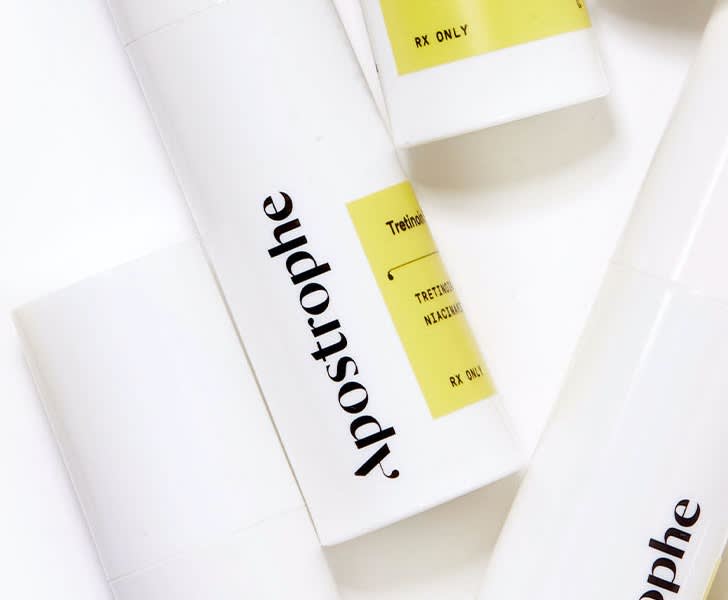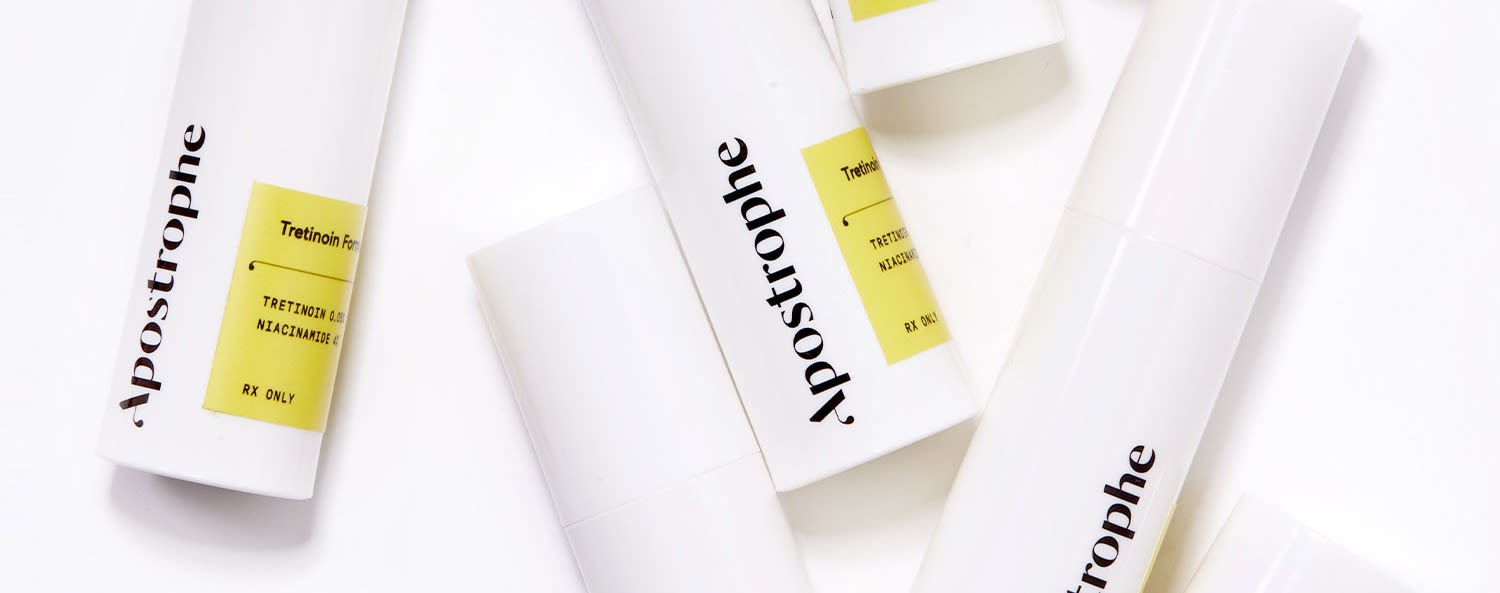Education
Fact or fiction: tretinoin myths


SHARE
Education
Fact or fiction: tretinoin myths
Medically reviewed by Aimee Paik, MD
Written by Apostrophe Team
Last updated 4/5/2024
For skincare nerds in the know, tretinoin is the Holy Grail when it comes to effective skincare ingredients. Over and over it has been clinically proven to boost radiance, prevent and treat wrinkles and fine lines, and help with acne. It may not be as trendy as rose quartz facial rollers or have the instant gratification of a pearl-infused serum, but tretinoin works. Unfortunately, the many benefits of tretinoin often come along with a side of irritated and flaky skin and there’s a lot of information out there about how to get all the pros without any of the cons. We’ve investigated some of the most common tretinoin myths and are here to help you separate fact from fiction.
Myth: You need to wait 20-30 minutes for skin to dry before applying tretinoin. Results: Mixed! Many participants in tretinoin forums will tout the importance of waiting for your skin to dry completely before applying tretinoin. The logic is this: wet or damp skin is more permeable than dry skin and will absorb more tretinoin, resulting in increased dryness and irritation. The premise of this myth is true: damp skin does absorb more product (which is why you should apply moisturizers and serums straight out of the shower!). However, the jury is still out on whether this increased absorption actually increases the irritating side effects of tretinoin, or if you would experience those side effects regardless. A few reputable sources support this claim, but not all dermatologists agree (including our own Medical Director, Dr. Aimee Paik). If your skin is very irritated from tretinoin use, you can test this myth out for yourself by waiting 20-30 minutes after showering or washing your face before applying tretinoin and seeing if your dryness subsides. It won’t harm your skin and you can use that time to de-stress after a long day!
Myth: You can use a moisturizer as a buffer to prevent tretinoin dryness. Results: True! Applying a moisturizer before applying tretinoin creates a barrier and dilutes tretinoin’s harsh effects. Dr. Lauren Kyle adds, “You could also try mixing the moisturizer and tretinoin together. You may need to invest in a thicker moisturizer for more moisture.” The extra hydration will also help mitigate flakiness while your skin adjusts to your tretinoin regimen.
Myth: You should only use tretinoin at night. Results: True! There are a couple different reasons why limiting your tretinoin use to the evening is a good idea. First, tretinoin becomes unstable when exposed to light. That means it becomes less effective when you wear it out and about during the day, rather than applying before bed as part of your night routine. Second, and more importantly, tretinoin makes your skin more susceptible to sun damage. This may seem counterintuitive since a known benefit of tretinoin is reversing signs of sun damage. However, tretinoin causes your skin to become more sensitive overall which also means it becomes more vulnerable to sun damage. Always, always, always use sunscreen with an SPF of at least 30 when using tretinoin to protect your skin and boost your treatment’s efficacy!
Myth: Tretinoin gel is more effective than tretinoin cream. Results: False! Tretinoin is the active ingredient in both the gel version and the cream version of this medication. The main difference comes from the formulation of the carrier substances: gel vs. cream. The gel contains much more alcohol which means that the drying effects of tretinoin may be enhanced (this may be why some people believe the tretinoin gel is more effective). This effect can be beneficial if you have an oilier skin type and are using tretinoin to treat acne. If you are using tretinoin to treat fine lines and wrinkles, you may find the cream version better suits your needs. The cream won’t enhance dryness (which can highlight fine lines) and may help curb tretinoin’s harsh side effects. If you are using a gel formula and find it too drying, consider asking your doctor about switching to a cream formula!
If you’re interested in tapping into tretinoin’s wonders for yourself, you can always get your hands on Apostrophe Tretinoin Formula (which uses a cream base to mitigate dryness 😉). And you can find lots of tips for combating tretinoin’s pesky side effects here! Remember: there’s a lot of information out there – when in doubt, always talk to your dermatology provider.
Have any other tretinoin myths you want us to investigate? Tweet at us @hi_apostrophe!
1. Mukherjee, S., Date, A., Patravale, V., Korting, H. C., Roeder, A., & Weindl, G. (2006). Retinoids in the treatment of skin aging: an overview of clinical efficacy and safety. Clinical Interventions in Aging, 1(4), 327–348. Retrieved from https://www.ncbi.nlm.nih.gov/pmc/articles/PMC2699641/ 2. My Routine for Starting on Tretinoin (Retin-A) Cream (With Video) . (2019, June 16). Retrieved December 26, 2019, from https://labmuffin.com/routine-starting-tretinoin-retin-cream/. 3. Schmidt, N., & Gans, E. H. (2011). Tretinoin: A Review of Its Anti-inflammatory Properties in the Treatment of Acne. The Journal of Clinical and Aesthetic Dermatology, 4(11), 22–29. Retrieved from https://www.ncbi.nlm.nih.gov/pmc/articles/PMC3225141/ 4. Tashtoush, B. M., Jacobson, E. L., & Jacobson, M. K. (2008). UVA is the major contributor to the photodegradation of tretinoin and isotretinoin: Implications for development of improved pharmaceutical formulations. International Journal of Pharmaceutics, 352(1-2), 123–128. Retrieved from https://www.ncbi.nlm.nih.gov/pubmed/18093761 5. Tretinoin (Topical Route) Proper Use. (2019, February 1). Retrieved December 26, 2019, from https://www.mayoclinic.org/drugs-supplements/tretinoin-topical-route/proper-use/drg-20066521. 6. Weiss, J. S. (1988). Topical Tretinoin Improves Photoaged Skin. JAMA, 259(4), 527–532. Retrieved from https://jamanetwork.com/journals/jama/article-abstract/370378
Shop this post

Tretinoin
Like what you just read? Sign up for our email list to get the scoop on skincare science delivered straight to your inbox.

Education
What is milia?
What is milia? Today, we’re jumping into one type of bump that you may have heard about most commonly in infants — milia.
Read More
Education
Best moisturizer for acne-prone skin
If you have combination acne-prone skin, figuring out which moisturizer is best for your skin might be tough. In this guide, we break down the best moisturizer for combination, acne-prone skin.
Read More
Education
How to build a face care routine
As you get into skincare, it might seem overwhelming, especially trying to figure out the order you're supposed to apply products in. Below, we detail how to build a face care routine for your skin!
Read More